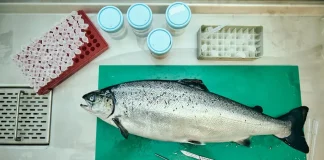 Leroy Seafoods and NGO, Bellona, cheered by Ocean Forest optimism
Leroy Seafoods and NGO, Bellona, cheered by Ocean Forest optimism
On the rear deck of the light- blue work boat, Lunnøy, technicians work their trade. Tow lines coated in leafy thin, light-brown, translucent brown algae (Laminaria saccharina) are winched aboard. The kelp is harvested in containers that stand stacked on the open deck.
“They have harvested for two weeks. Today is the last harvest day. And it’s surpassed all expectations,” says Harald Sveier.
He leads Leroy and (environmentalist NGO) Bellona’s joint venture, Ocean Forest, where a central focus is capturing nitrogen, phosphorous and carbon-dioxide by producing kelp close to marine grow-outs. Flatoyflu, a short boat ride from the ferry landing at Hufthamar, is one of two salmon sites the Leroy business has put aside for the purpose.
Resource
The idea is to introduce new aquaculture species produced for human consumption and feed.
“We want to capture resources otherwise lost, and we’ll be careful to make it biologically and economically sustainable. Plants need carbon-dioxide, phosphorous, nitrogen and sunlight to grow. That’s what you pay handsomely for at (your local plant nursery). Fish release that,” Sveier says.

Heavy, mottled grey clouds drive in from the North Sea and in over the archipelago (just south of Bergen). The drizzle is relentless. Kelp grows best in the spring, when it’s in its most protein-rich state. Over the summer, just as other species in warmer water grow on kelp, it forms carbohydrates, and in that way, corrodes. That’s why spring is the ideal harvest time.
Aiming to earn
“In Leroy’s mandate, there’s also an expectation that you ought to earn money for the effort. This year, I believe we’ll almost run a surplus,” Sveier says.
Ocean Forest achieved EUR 477,124 kroner in turnover last year. Sales were divided among the 40 tonnes of kelp. This year, there’ll be more.
“Kelp is used as a vegetable, as an additive or spice, as dry flakes in chips or as a feed ingredient for animals. This year we’ll produce 115 t. It’s relatively easy to scale-up. We don’t use chemicals or industrial salts,” he says.
Quality
Sugar kelp is more neutral in taste than, for example, bull kelp, which the company produces farther north in Hordaland County. Quality is key. Once the algae is harvested, it lasts just 2 hours on land.
Partner Bellona is optimistic about the value that lies in algae production.
“We think this will become a great industry for Norway, and what we’ve managed here at Ocean Forest shows that you can increase production significantly. It’s totally possible to industrialise this large-scale,” Anders Karlsson-Drangsholt, Bellona’s senior aquaculture advisor, tells SalmonBusiness.
“Since we believe (the oil industry in Norway) will recede, gradually, we (also) believe one needs raw material for biofuels, materials, petrochemical industries and textiles,” he adds.







